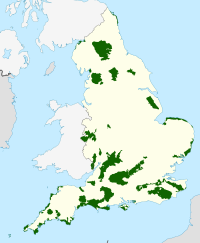Howardian Hills
Template:Geobox Protected Area
The Howardian Hills form an Area of Outstanding Natural Beauty in North Yorkshire, England. located between the Yorkshire Wolds, the North York Moors National Park and the Vale of York. The AONB includes farmland, wooded rolling countryside, villages and historic houses with parkland. The hills take their name from the noble Howard family who owned large areas of the hills.
Topography
The Howardian Hills form a roughly rectangular area of well-wooded undulating countryside rising between the flat agricultural Vales of Pickering and York. The irregular 170 metres (558 ft) ridges of the Howardian Hills are a southern extension of the rocks of the Hambleton Hills in the North York Moors. Jurassic limestone gives the landscape its character. The area contains a rich tapestry of wooded hills and valleys, pastures and rolling farmland, as well as extensive views from the higher ground across the agricultural plains below. On the eastern edge, the River Derwent cuts through the Hills in the Kirkham Gorge, a deep winding valley which was formed as an overflow channel from glacial Lake Pickering.[1]
History
In the spring of 1993 North Yorkshire County Council with the aid of a grant from the Royal Commission on the Historical Monuments of England carried out a field survey of the Howardian Hills to help in its preparation for a Management Plan for the area. Extensive cropmarks of discontinuous parallel ditches were recorded on the dip slope to either side of Barton le Street. Similar features are seen on the Yorkshire Wolds, their appearance suggesting adaptation and reuse of the landscape, over considerable periods of time and possibly serving different functions at different times. Also similar to the Yorkshire Wolds was the identification of square barrow cemeteries which sometimes appeared to be associated with trackways.[2]
Settlement
The AONB contains no towns, although the market towns of Helmsley and Malton lie just beyond the boundary. From Brandsby to Coneysthorpe is a line of spring line villages. The area has many attractive stone-built, red pantile-roofed buildings. It is the setting for a number of fine country houses, whose parklands are an intrinsic part of the landscape. These grand houses and designed landscapes, such as Castle Howard, Newburgh Priory, Hovingham Hall, Gilling Castle and Nunnington Hall, have a dramatic effect upon the scene. The most notable of these is Vanbrugh's famous masterpiece, Castle Howard.
Land use

High grade arable land, pasture and managed woodland makes this rich farming country whose diversity creates its attractive rural character.[1][3]
See also
References
- ^ a b "AONB Howardian Hills". Natural England. Retrieved 2008-05-20.
- ^ "Howardian Hills NMP". English Heritage. Retrieved 2008-05-20.
- ^ "Facts" (pdf). Retrieved 2008-05-21.
External links
- Bateman, J. (2006) 'Howardian Hills Field Collection Survey' John Bateman: York Archaeological Survey Report.
- Ampleforth Parish Council Village partly in the Howardian Hills AONB

